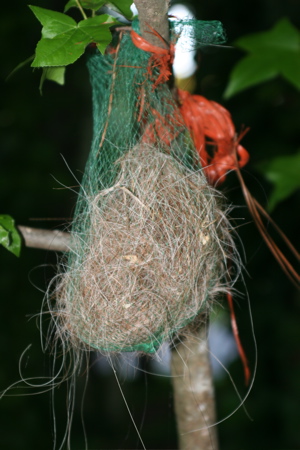-
Want more birds at your nyjer feeder?
There are no set rules in wild bird feeding, we offer birds different varieties of food that entice them and keep them coming back. Of course habitat plays a huge role, with places for shelter and nesting like mature trees, thickets and shrubs. The all important water source is also a big factor for attracting feathered friends.
Just because finches eat thistle, or nyjer seed, doesn’t mean they wont’ frequent other feeders offering different seed mixes. For the last few days, I’ve been seeing Black Capped Chickadees at the nyjer feeder. Now maybe it’s just the time of year, but I’ve never seen them at this feeder before. Also, the juvenile Eastern Bluebirds, who will eat suet during our cold winter months, have already started feeding at the suet feeder too.
A favorite treat for several birds is to mix thistle seed with finely chopped sunflower hearts. Placing this seed mix in the nyjer feeder attracts Juncos, Pine Siskins, Towhees and House and Purple Finches, as well as the Goldfinch.
In early spring, try offering nesting materials and encourage birds to take up residence by nesting in your yard. Collect dryer lint, pet hair, cotton yarns and fibers, and decorative mosses to create a nest ball with variety of materials that birds prefer. You can place them in a standard suet cage, or mesh produce bag from the grocery store. Of course commercial materials are available, and even some cool holders to accommodate them.
Just because the bright yellow feathers disappear in fall, it doesn’t mean these birds are gone. Remember to keep nyjer feeders out year round with fresh seed, as goldfinches and others will stick around during during winter months.
-
Entice Birds With Nesting Materials
Most folks start with birdhouses and bird feeders to attract wild birds, and this is the perfect way to explore the great hobby of backyard birding. There are many other ways to increase the number of visitors and the number of species to your yard. Water is the number one element. Many birds who never visit a feeder will frequent a yard that offers a continuous fresh water source like a bird bath. Especially during frigid winters when water sources tend to freeze and become scarce, birds depend on a known spot for fresh water. Our bluebirds even over-wintered here in North Georgia, largely because of the three heated bird baths in the yard. Oh yes, the live mealworms helped too!
Many desired songbirds birds (like cardinals and finches) are not cavity-dwellers either, meaning they’ll never use a birdhouse.
Which brings us to yet another feathered friend favorite. Nesting materials are extremely important to birds in early spring. With a severe shortage in natural habitats, many depend on bird-friendly yards for their residence. There are all kinds of kits which offer refills too. This nesting material wreath is one, complete with feathers, cotton fibers, hemp, and raffia. The Bird Nester is a large, cage-like holder for cotton fiber nesting material, and offers refills as well. Even the Hummer Helper, which is nesting material designed specifically for hummingbirds offers refills.
Offering wild birds nesting materials in your yard really helps them to thrive and flourish. You can even craft your own materials using dryer lint, pet hair, cotton yarns, and mosses used in decorative floral design. Use a standard suet cage for holding the materials, or a mesh produce bag from the grocery store (like the kind apples come in). Late winter to very early spring is the best time to set them outside for birds. Simply hang from a tree branch, where they’ll be easily spotted, or even from one of the arms on your shepherd’s hook……happy birding!
-
Simple Nesting Material for Your Birds
Entice and encourage birds to nest in your yard with simple materials found around your home. Although there are all kinds of cool nesting material kits out there, you can do this one yourself… easily!
Start with a suet cage or even a mesh produce bag, like the kind apples come in at the grocery store. Next time you empty the lint basket in your clothes dryer, nix that soft, fluffy material as it’s just not natural.
Got a cat or dog? Pet hair is keeper. If you brush your pet, save the hair that accumulates in their brush. But steer clear if Fido or Fluffy has been treated with flea & tick meds. If you happen to have a horse… even better! The nesting material shown here is horse hair. Mostly from the mane and tail, it makes for great stuff to help bind the birds’ gatherings into a nest.
Ever work with silk or dried flowers? The decorative moss, especially Spanish or sphagnum moss is wonderful. Stuff a little moss into the nesting ball too, but keep strands short. They even like bits of raffia and especially feathers. Hang your nest ball from a branch in a visible spot for birds to easily see it. Somewhere in the proximity of existing bird feeders or birdhouses is best. Don’t pack the materials too tightly as a generous air flow dries them quicker after rain.
Simple materials from around your home, that are usually discarded, make for great nesting materials to help birds thrive and flourish in your backyard. You can entice birds to stick around, without adding more feeders and houses, but by offering valuable nesting material for them to help raise their families. Don’t forget the shallow fresh water too!




